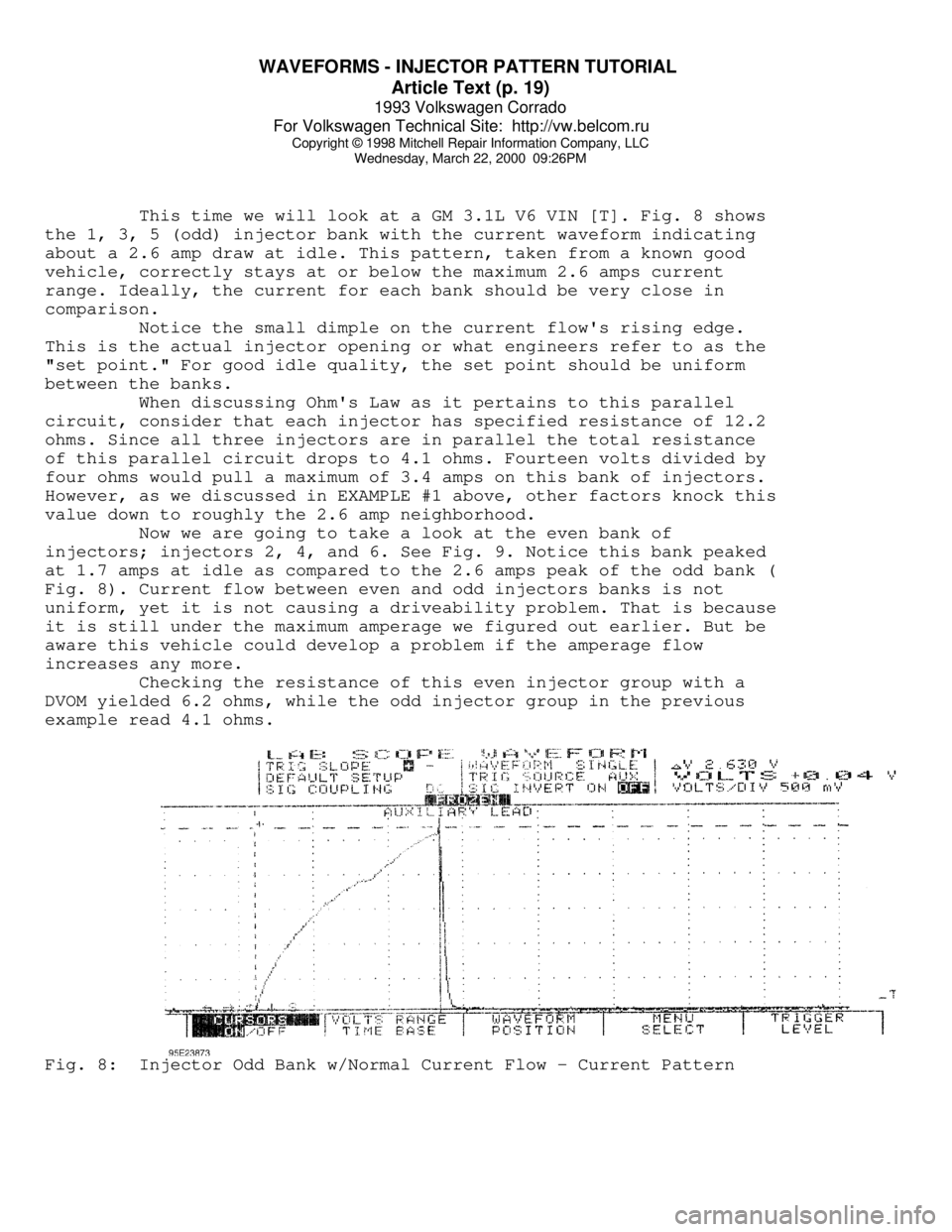1993 VOLKSWAGEN CORRADO hood open
[x] Cancel search: hood openPage 323 of 920

A/C COMPRESSOR OIL CHECKING
Article Text (p. 9)
1993 Volkswagen Corrado
For Volkswagen Technical Site: http://vw.belcom.ru
Copyright © 1998 Mitchell Repair Information Company, LLC
Wednesday, March 22, 2000 08:47PM
process is completed, the amount of compressor oil removed must be
measured and the same amount added to A/C system.
DISCONNECTING LINES & FITTINGS
After system is discharged, carefully clean area around all
fittings to be opened. Always use 2 wrenches when tightening or
loosening fittings. Some refrigerant lines are connected with a
coupling. Special tools may be required to disconnect lines. Cap or
plug all openings as soon as lines are removed. DO NOT remove caps
until connections of lines and fittings are completed.
CONNECTING LINES & FITTINGS
NOTE: All R-134a based systems use 1/2-16 ACME threaded fittings.
Ensure all replacement parts match the connections of the
system being worked on.
Always use a new gasket or "O" ring when connecting lines or
fittings. Coat "O" ring with refrigerant oil and ensure it is not
twisted during installation. Always use 2 wrenches to prevent damage
to lines and fittings.
PLACING SYSTEM IN OPERATION
After component service or replacement has been completed and
all connections have been made, evacuate system thoroughly with a
vacuum pump. Charge system with proper amount of refrigerant and
perform leak test. See REFRIGERANT OIL & REFRIGERANT SPECIFICATIONS
article in GENERAL SERVICING for system capacities. Check all fittings
that have been opened. After system has been leak tested, check system
performance.
NOTE: Most compressors are pre-charged with a fixed amount of
refrigerant (shipping) oil. Drain compressor oil from new
compressor and add refrigerant oil to new compressor
according to amount removed from old compressor. Always
refer to underhood A/C specification label or A/C compressor
label while servicing A/C system.
ATSUGI
ROTARY VANE
1) Before checking and adjusting oil level, operate engine at
1200 RPM. Set controls at maximum cooling and high blower motor speed
for 10 minutes to return oil to compressor.
2) Stop engine. Discharge refrigerant and remove compressor
from vehicle. See SERVICING PRECAUTIONS. Drain compressor oil through
compressor discharge port and measure oil amount.
3) If amount drained is less than 3 ounces, conduct leak
tests at system connections. Repair or replace faulty parts as
Page 363 of 920

A/C SYSTEM GENERAL DIAGNOSTIC PROCEDURES
Article Text
1993 Volkswagen Corrado
For Volkswagen Technical Site: http://vw.belcom.ru
Copyright © 1998 Mitchell Repair Information Company, LLC
Wednesday, March 22, 2000 08:48PM
ARTICLE BEGINNING
1993 AIR CONDITIONING & HEAT
A/C General Diagnostic Procedures
Diagnosis is an important first step in A/C system servicing.
To save time and effort, systems should be carefully checked to
identify the causes of poor performance. By using the following
diagnostic charts, defective components or system problems can be
quickly located. To identify problems that are specific to one system,
refer to the repair section of this manual. The charts in this section
apply to all systems.
PREPARATION FOR TESTING
1) Attach Low and High pressure gauges.
2) Start engine and allow to warm up.
3) Set system to COOL and blower to HIGH.
4) Open car doors and hood.
5) Run engine at fast idle for 2-3 minutes.
AIR CONDITIONING SYSTEM PERFORMANCE CHECK
AIR CONDITIONING SYSTEM PERFORMANCE CHECK TABLEÄÄÄÄÄÄÄÄÄÄÄÄÄÄÄÄÄÄÄÄÄÄÄÄÄÄÄÄÄÄÄÄÄÄÄÄÄÄÄÄÄÄÄÄÄÄÄÄÄÄÄÄÄÄÄÄÄÄÄÄÄÄÄÄÄÄÄÄÄPERFORM TESTS: SHOULD BE: IF:
ÄÄÄÄÄÄÄÄÄÄÄÄÄÄÄÄÄÄÄÄÄÄÄÄÄÄÄÄÄÄÄÄÄÄÄÄÄÄÄÄÄÄÄÄÄÄÄÄÄÄÄÄÄÄÄÄÄÄÄÄÄÄÄÄÄÄÄÄÄTemperature Check Temperature Check Is:
* Switch to LOW blower.
* Close doors.
* Check outlet temperature. 35-45
ø F Too warm - Check
control lever
operation, heater
water valve, cooling
system and gauge readings.
ÄÄÄÄÄÄÄÄÄÄÄÄÄÄÄÄÄÄÄÄÄÄÄÄÄÄÄÄÄÄÄÄÄÄÄÄÄÄÄÄÄÄÄÄÄÄÄÄÄÄÄÄÄÄÄÄÄÄÄÄÄÄÄÄÄÄÄÄÄPERFORM TESTS: SHOULD BE: IF:
ÄÄÄÄÄÄÄÄÄÄÄÄÄÄÄÄÄÄÄÄÄÄÄÄÄÄÄÄÄÄÄÄÄÄÄÄÄÄÄÄÄÄÄÄÄÄÄÄÄÄÄÄÄÄÄÄÄÄÄÄÄÄÄÄÄÄÄÄÄVisual Check Visual Check Shows:
* Compressor Quiet with no leaks Noisy - Check belts,
oil level, seals,
gaskets, reed valves.
* Condenser Free of obstructions Blocked - Clean off.
Plugged - Flush or
replace.
* Receiver-Drier Dry and warm to touch Frosty - Check for
restriction, replace
desiccant.
Page 423 of 920

ANTI-THEFT SYSTEM
Article Text
1993 Volkswagen Corrado
For Volkswagen Technical Site: http://vw.belcom.ru
Copyright © 1998 Mitchell Repair Information Company, LLC
Wednesday, March 22, 2000 08:57PM
ARTICLE BEGINNING
1993 ACCESSORIES & EQUIPMENT
Volkswagen Anti-Theft
Volkswagen; Corrado SLC, Passat
DESCRIPTION & OPERATION
The anti-theft system monitors the radio, all doors, hood and
trunk lid position. When the anti-theft system is activated, The horn
and emergency flashers will be activated and the vehicle will not
start. The windows and sun roof (if equipped) are not monitored.
The anti-theft system has self-diagnostic capabilities that
monitor all components and wiring harness. If the system is
functioning correctly, the horn will sound briefly after front door is
locked with the key.
ANTI-THEFT CONTROL MODULE LOCATION TABLEÄÄÄÄÄÄÄÄÄÄÄÄÄÄÄÄÄÄÄÄÄÄÄÄÄÄÄÄÄÄÄÄÄÄÄÄÄÄÄÄÄÄÄÄÄÄÄÄÄÄÄÄÄÄÄÄÄÄÄÄModel Location
Corrado SLC ...................... Behind Right Kick Panel
Passat ...................... Driver Side Fuse/Relay Panel
ÄÄÄÄÄÄÄÄÄÄÄÄÄÄÄÄÄÄÄÄÄÄÄÄÄÄÄÄÄÄÄÄÄÄÄÄÄÄÄÄÄÄÄÄÄÄÄÄÄÄÄÄÄÄÄÄÄÄÄÄ TROUBLE SHOOTING
SYSTEM DOES NOT OPERATE
NOTE: Ensure battery is fully charged and all fuses are okay.
1) Ground Circuit Check
Obtain radio security code. Disconnect battery cable
terminals. Disconnect anti-theft control module 6-pin and 10-pin
wiring harness connector. See ANTI-THEFT CONTROL MODULE LOCATION
table. Connect ohmmeter negative lead to ground. Connect positive lead
to anti-theft control module 10-pin wiring harness connector terminal
No. "3" (Brown wire). If continuity is present, go to next step. If
continuity is not present, repair open circuit.
2) Power Circuit Check
Connect battery cable terminals. Connect voltmeter negative
lead to ground. Connect positive lead to anti-theft control module 6-
pin wiring harness connector terminal No. "3" (Red wire). Switch
positive lead to anti-theft control module 10-pin wiring harness
connector terminal No. "1" (Red wire). If 12 volts are present at both
terminals, go to next step. If 12 volts are not present, repair open
circuit.
3) Turn ignition on. Leave voltmeter negative lead connected
to ground. Connect positive lead to anti-theft control module 10-pin
wiring harness connector terminal No. "4" (Black wire for Corrado;
Page 424 of 920

ANTI-THEFT SYSTEM
Article Text (p. 2)
1993 Volkswagen Corrado
For Volkswagen Technical Site: http://vw.belcom.ru
Copyright © 1998 Mitchell Repair Information Company, LLC
Wednesday, March 22, 2000 08:57PM
Black/Yellow wire for Passat). If 12 volts are present, go to next
step. If 12 volts are not present, repair open circuit.
4) Alarm Horn Check
Turn ignition off. Connect ohmmeter negative lead to ground.
Connect positive lead to anti-theft control module 6-pin wiring
harness connector terminal No. "4" (Black/Yellow wire). If continuity
is present, go to next step. If continuity is not present, repair open
circuit. If circuit is okay, replace alarm horn.
5) Door Lock Switch Check
Connect voltmeter negative lead to ground. Connect positive
lead to anti-theft control module 10-pin wiring harness connector
terminal No. "7" (Red/Yellow wire for Corrado; Yellow/Red for Passat).
Insert key in driver's door lock. Turn key to lock position and hold
momentarily. Voltmeter should register 12 volts. Repeat procedure for
passengers door. If voltage is correct for each door, go to next step.
If voltage is not correct, repair open circuit or replace switch.
6) Door Lock Switch Check
Connect voltmeter negative lead to ground. Connect positive
lead to anti-theft control module 10-pin wiring harness connector
terminal No. "6" (Red/Black wire). Insert key in driver's door lock.
Turn key to unlocked position and hold momentarily. Voltmeter should
register 12 volts. Repeat procedure for passengers door. If voltage is
correct for each door, go to next step. If voltage is not correct,
repair open circuit or replace switch.
7) Alarm Switch & Hood Check
Connect ohmmeter negative lead to ground. Disconnect negative
battery cable. Connect positive lead to the following anti-theft
control module connector terminals:
* 10-pin harness connector terminal No. "5" (Gray wire).
* 10-pin harness connector terminal No. "8" (Brown/Red wire).
* 10-pin harness connector terminal No. "9" (Brown/Green wire).
* 10-pin harness connector terminal No. 10 (Brown/White wire for
Corrado SLC; Brown/Green wire for Passat).
If continuity is present, check for circuit short to ground. If
circuit is okay, replace switch. If continuity is not present, go to
next step.
8) Indicator Light Check
Leave ohmmeter negative lead connected to ground. Connect
negative battery cable. Using multimeter set on 10 A DC scale, connect
positive lead to anti-theft control module 10-pin wiring harness
connector terminal No. "2". If indicator light comes on, replace anti-
theft control module. If indicator light does not come on, repair open
circuit in wiring harness.
ALARM SYSTEM WILL NOT SWITCH OFF
1) Ground Circuit Check
Ensure battery is fully charged. Obtain radio security code.
Disconnect battery cable terminals. Disconnect anti-theft control
module 6-pin and 10-pin wiring harness connector. See ANTI-THEFT
CONTROL MODULE LOCATION table. Reconnect battery cable terminals.
2) Connect voltmeter negative lead to ground. Connect
Page 762 of 920

VR65 ENGINE: AFFIX NEW VACUUM HOSE ROUTING LABEL
Article Text (p. 3)
1993 Volkswagen Corrado
For Volkswagen Technical Site: http://vw.belcom.ru
Copyright © 1998 Mitchell Repair Information Company, LLC
Wednesday, March 22, 2000 09:26PM
From 50_PK 003 050 through 50_PK 005 031 ³ A, B, C, and D
From 50_NK 004 148 through 50_NK 012 142
³ A, C, D, E, F and G
³ (automatic transmission
³ vehicles)
ÄÄÄÄÄÄÄÄÄÄÄÄÄÄÄÄÄÄÄÄÄÄÄÄÄÄÄÄÄÄÄÄÄÄÄÄÄÄÄÄÄÄÄÁÄÄÄÄÄÄÄÄÄÄÄÄÄÄÄÄÄÄÄÄÄÄÄÄÄÄ REPAIR STEPS EXPLANATION:
Repair Step A - Secure Cooling Fan Wiring Harness
Repair Step B - Modify Shift Linkage Balance Weight Mounting
(Standard Transmission Only)
Repair Step C - Re-route Ignition Cables and Breather Hose
Repair Step D - Secure Engine Compartment Harness
Repair Step E - Secure Exhaust System
Repair Step F - Replace Transmission Control Module (Automatic
Transmission Only)
Repair Step G - Replace Vacuum Hose Routing Label
WORK PROCEDURE
A. Secure Cooling Fan Wiring Harness
- Open hood
- Connect power saver to protect radio code
- Remove battery
- Disconnect harness plug from fan motor
- Cut protective sleeve, part number N 905 930.01 into
individual lengths according to the indicated measurements
in Fig. 1.
- Pull open each protective sleeve longways and slide over
harness according to Fig. 1.Fig. 1: Protective Sleeve Measurements
- Place protective sleeves approx. 10mm from each branching off
Page 878 of 920

WAVEFORMS - INJECTOR PATTERN TUTORIAL
Article Text (p. 19)
1993 Volkswagen Corrado
For Volkswagen Technical Site: http://vw.belcom.ru
Copyright © 1998 Mitchell Repair Information Company, LLC
Wednesday, March 22, 2000 09:26PM
This time we will look at a GM 3.1L V6 VIN [T]. Fig. 8 shows
the 1, 3, 5 (odd) injector bank with the current waveform indicating
about a 2.6 amp draw at idle. This pattern, taken from a known good
vehicle, correctly stays at or below the maximum 2.6 amps current
range. Ideally, the current for each bank should be very close in
comparison.
Notice the small dimple on the current flow's rising edge.
This is the actual injector opening or what engineers refer to as the
"set point." For good idle quality, the set point should be uniform
between the banks.
When discussing Ohm's Law as it pertains to this parallel
circuit, consider that each injector has specified resistance of 12.2
ohms. Since all three injectors are in parallel the total resistance
of this parallel circuit drops to 4.1 ohms. Fourteen volts divided by
four ohms would pull a maximum of 3.4 amps on this bank of injectors.
However, as we discussed in EXAMPLE #1 above, other factors knock this
value down to roughly the 2.6 amp neighborhood.
Now we are going to take a look at the even bank of
injectors; injectors 2, 4, and 6. See Fig. 9. Notice this bank peaked
at 1.7 amps at idle as compared to the 2.6 amps peak of the odd bank (
Fig. 8). Current flow between even and odd injectors banks is not
uniform, yet it is not causing a driveability problem. That is because
it is still under the maximum amperage we figured out earlier. But be
aware this vehicle could develop a problem if the amperage flow
increases any more.
Checking the resistance of this even injector group with a
DVOM yielded 6.2 ohms, while the odd injector group in the previous
example read 4.1 ohms.Fig. 8: Injector Odd Bank w/Normal Current Flow - Current Pattern
Page 900 of 920

WIPER/WASHER SYSTEM
Article Text
1993 Volkswagen Corrado
For Volkswagen Technical Site: http://vw.belcom.ru
Copyright © 1998 Mitchell Repair Information Company, LLC
Wednesday, March 22, 2000 09:27PM
ARTICLE BEGINNING
1993 ACCESSORIES & EQUIPMENT
Volkswagen Wiper/Washer Systems
Volkswagen; Corrado SLC
DESCRIPTION
All models are equipped with 2-speed wipers. A standard or
optional intermittent feature is also available. The wiper control is
the right lever on the steering column. Some models are equipped with
a rear wiper/washer system.
ADJUSTMENTS
WIPER BLADE
To adjust wiper blade park position, ensure wiper motor is at
park position. Locate wiper blade(s) above lower edge of windshield as
specified. See WIPER BLADE PARK POSITION SPECIFICATION table. Secure
wiper arm.
WIPER BLADE PARK POSITION SPECIFICATION TABLEÄÄÄÄÄÄÄÄÄÄÄÄÄÄÄÄÄÄÄÄÄÄÄÄÄÄÄÄÄÄÄÄÄÄÄÄÄÄÄÄÄÄÄÄÄÄÄÄÄÄÄÄÄÄÄÄÄÄÄÄApplication In. (mm)
Corrado SLC
Right .......................................... 1.0 (25)
Left ........................................... 1.8 (47)
Rear ........................................... 1.9 (50)
ÄÄÄÄÄÄÄÄÄÄÄÄÄÄÄÄÄÄÄÄÄÄÄÄÄÄÄÄÄÄÄÄÄÄÄÄÄÄÄÄÄÄÄÄÄÄÄÄÄÄÄÄÄÄÄÄÄÄÄÄ TESTING
Testing information is not available from manufacturer.
REMOVAL & INSTALLATION
FRONT WIPER MOTOR
Removal
Open hood, and unplug wiring connector. Pry linkage off motor
crank arm. Remove mounting bolts and motor. DO NOT remove motor
bracket when removing motor.
Installation
Check crank arm alignment by running motor and allowing arm
to park. Ensure crank arm is properly aligned. See Fig. 1. To complete